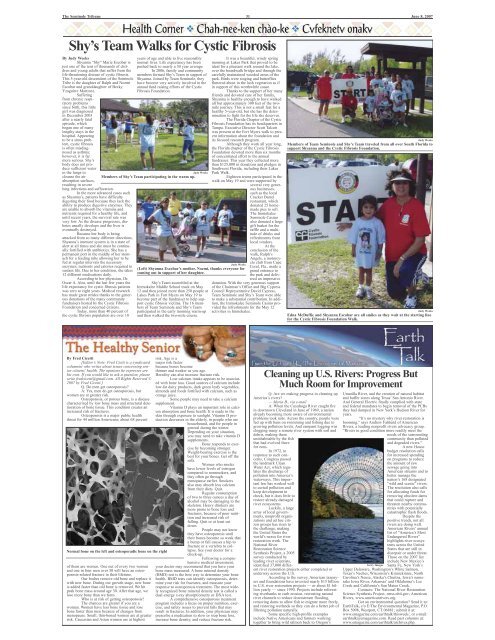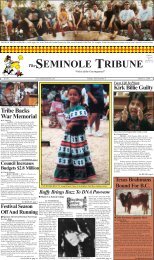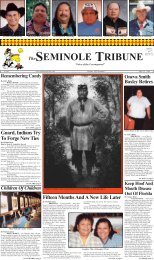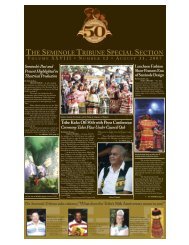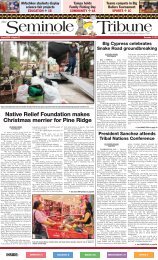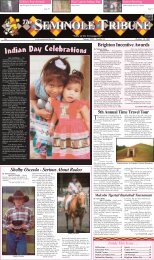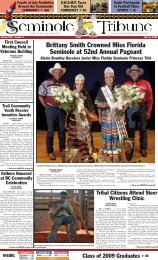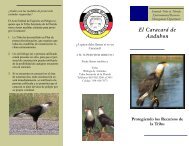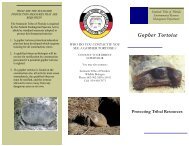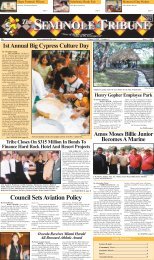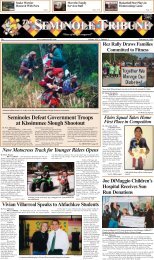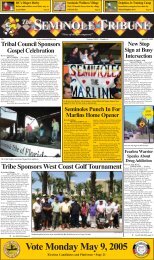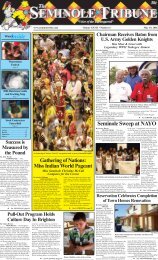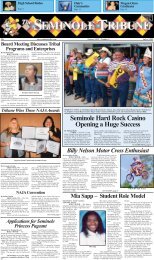Create successful ePaper yourself
Turn your PDF publications into a flip-book with our unique Google optimized e-Paper software.
The <strong>Seminole</strong> Tribune 31 <strong>June</strong> 8, 2007Shy’s Team Walks for Cystic FibrosisBy Judy WeeksShyanna “Shy” Marie Escobar isjust one <strong>of</strong> the tens <strong>of</strong> thousands <strong>of</strong> childrenand young adults that suffer from thelife-threatening disease <strong>of</strong> cystic fibrosis.This 5-year-old descendent <strong>of</strong> the <strong>Seminole</strong><strong>Tribe</strong> is the daughter <strong>of</strong> Ralph and NoemiEscobar and granddaughter <strong>of</strong> BeckyYzaguirre Martinez.Sufferingfrom chronic respiratoryproblemssince birth, this littlegirl was diagnosedin December 2003after a nearly fatalepisode, whichbegan one <strong>of</strong> manylengthy stays in thehospital. Appearingto be a sinus problem,cystic fibrosisis <strong>of</strong>ten misdiagnosedas asthma;however, it is farmore serious. Shy’sbody does not producesufficient waterin the lungs tocleanse the airabsorption surfaces,resulting in severelung infections and suffocation.In the more advanced cases suchas Shyanna’s, patients have difficultydigesting their food because they lack theability to produce digestive enzymes. Theyare unable to absorb the vitamins andnutrients required for a healthy life, anduntil recent years, the survival rate wasvery low. As the disease progresses, diabetesusually develops and the liver iseventually destroyed.Because her body is beingattacked from so many different directions,Shyanna’s immune system is in a state <strong>of</strong>alert at all times and she must be continuallyfortified with antibiotics. She has apermanent port in the middle <strong>of</strong> her stomachfor a feeding tube allowing her to befed at regular intervals the necessaryenzymes, nutrients and calories required tosustain life. Due to her condition, she takes12 different medications daily.According to her physician, Dr.Oscar A. Alea, until the last few years thelife expectancy for cystic fibrosis patientswas zero to eight years. Medical researchhas made great strides thanks to the generousdonations <strong>of</strong> the many communityfundraisers hosted by the Cystic FibrosisFoundation and concerned citizens.Today, more than 40 percent <strong>of</strong>the cystic fibrosis population are over 18years <strong>of</strong> age and able to live reasonablynormal lives. Life expectancy has beenpushed back to nearly a 30 year average.In 2006, family and communitymembers formed Shy’s Team in support <strong>of</strong>Shyanna. Joined by Team <strong>Seminole</strong>, theyhave become very actively involved in theannual fund raising efforts <strong>of</strong> the CysticFibrosis Foundation.Judy WeeksMembers <strong>of</strong> Shy’s Team participating in the warm up.Judy Weeks(Left) Shyanna Escobar’s mother, Noemi, thanks everyone forcoming out in support <strong>of</strong> her daughter.Shy’s Team assembled at theImmokalee Middle School track on May12 and then joined more than 250 people atLakes Park in Fort Myers on May 19 tobecome part <strong>of</strong> the fundraiser to help supportcystic fibrosis victims. The 16 members<strong>of</strong> Team <strong>Seminole</strong> and Shy’s Teamparticipated in the early morning warm-upand then walked the two-mile course.It was a beautiful, windy springmorning at Lakes Park that proved to beideal for a pleasant walk around the lake,over the boardwalk bridge and through thecarefully maintained wooded areas <strong>of</strong> thepark. Birds were singing and butterfliesfluttered about in the lush vegetation as ifin support <strong>of</strong> this worthwhile cause.Thanks to the support <strong>of</strong> her manyfriends and devoted care <strong>of</strong> her family,Shyanna is healthy enough to have walkedall but approximately 300 feet <strong>of</strong> the twomilejourney. This is not a small feat for ahealthy 5-year-old, but she has the determinationto fight for the life she deserves.The <strong>Florida</strong> Chapter <strong>of</strong> the CysticFibrosis Foundation has its headquarters inTampa. Executive Director Scott Talcottwas present at the Fort Myers walk to presentinformation about the foundation andits focused research program.Although they work all year long,the <strong>Florida</strong> chapter <strong>of</strong> the Cystic FibrosisFoundation devoted more than six months<strong>of</strong> concentrated effort to the annualfundraiser. This year they collected morethan $125,000 in donations and pledges inSouthwest <strong>Florida</strong>, including their LakesPark Walk.Eighteen teams participated in thewalk on May 19 and were supported byseveral very generousbusinesses,such as the localCracker Barrelrestaurant, whichdonated 25 homemadepies to sell.The Immokalee<strong>Seminole</strong> Casinoalso donated a largegift basket for theraffle and a multitude<strong>of</strong> drinks andrefreshments fromlocal vendors.At theconclusion <strong>of</strong> thewalk, Ralph’sAngels, a motorcycleclub from CapeCoral, Fla., made agrand entrance tothe park and deliveredan impressivedonation. With the very generous support<strong>of</strong> the Chairman’s Office and Big CypressCouncil Representative David Cypress,Team <strong>Seminole</strong> and Shy’s Team were ableto make a substantial contribution. In addition,the Immokalee <strong>Seminole</strong> Casino providedthe refreshments for the May 12activities in Immokalee.Judy WeeksMembers <strong>of</strong> Team <strong>Seminole</strong> and Shy’s Team traveled from all over South <strong>Florida</strong> tosupport Shyanna and the Cystic Fibrosis Foundation.Judy WeeksEdna McDuffie and Shyanna Escobar are all smiles as they wait at the starting linefor the Cystic Fibrosis Foundation Walk.By Fred Cicetti[Editor’s Note: Fred Cietti is a syndicatedcolumnist who writes about issues concerning seniorcitizens’ health. The opinions he expresses arehis own. If you would like to ask a question, pleasewrite fredcicetti@gmail.com. All Rights Reserved ©2007 by Fred Cicetti.]Q. Do men get osteoporosis?A: Yes, men do get osteoporosis, butwomen are at greater risk.Osteoporosis, or porous bone, is a diseasecharacterized by low bone mass and structural deterioration<strong>of</strong> bone tissue. This condition creates anincreased risk <strong>of</strong> fractures.Osteoporosis is a major public healththreat for 44 million Americans; about 68 percentNormal bone on the left and osteoporadic bone on the right<strong>of</strong> them are women. One out <strong>of</strong> every two womenand one in four men over 50 will have an osteoporosis-relatedfracture in their lifetime.Our bodies remove old bone and replace itwith new bone. During our growth stage, new boneis added faster than old bone is removed. We hitpeak bone mass around age 30. After that age, welose more bone than we form.Who is at risk <strong>of</strong> getting osteoporosis?The chances are greater if you are awoman. Women have less bone tissue and losebone faster than men because <strong>of</strong> changes frommenopause. Small, thin-boned women are at greaterrisk. Caucasian and Asian women are at highestrisk. Age is amajor risk factorbecause bones becomethinner and weaker as you age.Heredity can also increase fracture risk.Low calcium intake appears to be associatedwith bone loss. Good sources <strong>of</strong> calcium includelow-fat dairy products, dark green leafy vegetables,almonds and foods fortified with calcium, such asorange juice.Some people may need to take a calciumsupplement.Vitamin D plays an important role in calciumabsorption and bone health. It is made in theskin through exposure to sunlight. Vitamin D productiondecreases in the elderly, in people who arehousebound, and for people ingeneral during the winter.Depending on your situation,you may need to take vitamin Dsupplements.Bone responds to exerciseby becoming stronger.Weight-bearing exercise is thebest for your bones. Get <strong>of</strong>f thes<strong>of</strong>a.Women who smokehave lower levels <strong>of</strong> estrogencompared to nonsmokers, andthey <strong>of</strong>ten go throughmenopause earlier. Smokersalso may absorb less calciumfrom their diets. Quit.Regular consumption<strong>of</strong> two to three ounces a day <strong>of</strong>alcohol may be damaging to theskeleton. Heavy drinkers aremore prone to bone loss andfractures, because <strong>of</strong> poor nutritionand increased risk <strong>of</strong>falling. Quit or at least cutdown.People may not knowthey have osteoporosis untiltheir bones become so weak thata bump or fall causes a hip t<strong>of</strong>racture or a vertebra to collapse.See your doctor for acheck-up.Following a comprehensivemedical assessment,your doctor may recommend that you have yourbone mass measured. A bone mineral density(BMD) test is the best way to determine your bonehealth. BMD tests can identify osteoporosis, determineyour risk for fractures, and measure yourresponse to osteoporosis treatment. The most widelyrecognized bone mineral density test is called adual-energy x-ray absorptiometry or DXA test.A comprehensive osteoporosis treatmentprogram includes a focus on proper nutrition, exercise,and safety issues to prevent falls that mayresult in fractures. In addition, your physician mayprescribe a medication to slow or stop bone loss,increase bone density, and reduce fracture risk.Cleaning up U.S. Rivers: Progress ButMuch Room for ImprovementQ: Are we making progress in cleaning upAmerica’s rivers?— Maria B., via e-mailA: When the Cuyahoga River caught firein downtown Cleveland in <strong>June</strong> <strong>of</strong> 1969, a nationalready becoming more aware <strong>of</strong> environmentalproblems took note. Across the country, people werefed up with bans on swimming and fishing due togrowing pollution levels. And rampant logging wasclogging many a remote river system with soil anddebris, making themuninhabitable by the fishthat had evolved therefor eons.In 1972, inresponse to such concerns,Congress passedthe landmark CleanWater Act, which regulatesthe discharge <strong>of</strong>pollution into America’swaterways. This importantlaw has worked wellto curtail pollution andkeep development incheck, but it does little torestore already damagedriver ecosystems.Luckily, a largearray <strong>of</strong> local governments,nonpr<strong>of</strong>it organizationsand ad hoc citizengroups has risen tothe challenge, makingthe United States theworld’s nexus for riverrestoration work. TheNational RiverRestoration ScienceSynthesis Project, a 2005survey conducted byleading river scientists,identified 37,000 differentriver restoration projects either completed orunderway across the U.S.According to the survey, American taxpayersand foundations have invested nearly $15 billionin U.S. river restoration projects — or about $1 billionyearly — since 1990. Projects include reforestingriverbanks to curb erosion, recreating naturalriver channels to reduce downstream flooding,removing dams to allow fish to migrate more freely,and restoring wetlands so they can do a better job <strong>of</strong>filtering pollution naturally.Some specific high-pr<strong>of</strong>ile examplesinclude Native Americans and farmers workingtogether to bring wild salmon back to Oregon’sUmatilla River, and the creation <strong>of</strong> natural habitatand buffer zones along Texas’ San Antonio River.And General Electric finally complied with stateand federal mandates to begin removal <strong>of</strong> the PCBsthey had dumped in New York’s Hudson River foryears.“It’s no mystery why river restoration isbooming,” says Andrew Fahlund <strong>of</strong> AmericanRivers, a leading nonpr<strong>of</strong>it rivers advocacy group.“Rivers in good condition more readily meet theneeds <strong>of</strong> the surroundingcommunity than pollutedand degraded rivers.”A new Housebudget resolution callsfor increased spendingon programs to reducethe amount <strong>of</strong> rawsewage going intoAmerican streams and tobetter manage thenation’s 168 designated“wild and scenic” rivers.The resolution also callsfor allocating funds forremoving obsolete damsthat could rupture andthreaten nearby communitieswith potentiallycatastrophic flash floods.Despite thepositive trends, not allrivers are doing well.American Rivers’ annuallist <strong>of</strong> “America’s MostEndangered Rivers”highlights river ecosystemsacross the UnitedStates that are still indisrepair or under threat.Those on the 2007 listinclude New Mexico’sSanta Fe, New York’sGetty ImagesUpper Delaware, Washington’s White Salmon,Texas’s Neches, Wisconsin’s Kinnickinnic, NorthCarolina’s Neuse, Alaska’s Chuitna, Iowa’s namesakeIowa River, Arkansas’ and Oklahoma’s LeeCreek and California’s San Mateo Creek.Contacts: The National River RestorationScience Synthesis Project, nrrss.nbii.gov; AmericanRivers, www.americanrivers.org.Got an environmental question? Send it to:EarthTalk, c/o E/The Environmental Magazine, P.O.Box 5098, Westport, CT 06881; submit it at:www.emagazine.com/earthtalk/thisweek/, or e-mail:earthtalk@emagazine.com. Read past columns at:www.emagazine.com/earthtalk/archives.php.


